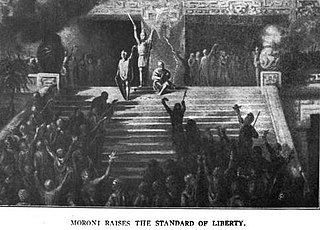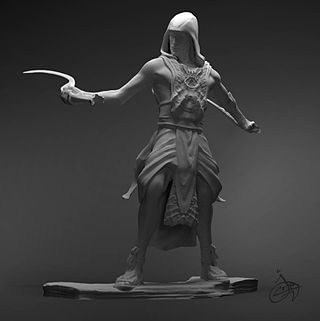
The Book of Alma: The Son of Alma, usually referred to as the Book of Alma, is one of the books that make up the Book of Mormon. The title refers to Alma the Younger, a prophet and "chief judge" of the Nephites. Alma is the longest book in the Book of Mormon and consists of sixty-three chapters, taking up almost a third of the volume.
The Book of Mosiah is one of the books which make up the Book of Mormon. The title refers to Mosiah II, a king of the Nephites at Zarahemla. The book covers the time period between ca 130 BC and 91 BC, except for when the book has a flashback into the Record of Zeniff, which starts at ca 200 BC, according to footnotes. Aside from stating that it was abridged by Mormon, the text says nothing about its authorship. Mosiah is twenty-nine chapters long.
According to the beliefs of the Church of Jesus Christ of Latter-day Saints, Zarahemla refers to a large city in the ancient Americas which is described in the Book of Mormon. Archaeologists and historians have not been able to archaeologically verify a location for any such city.

According to the Book of Mormon, Alma was a Nephite prophet who established the Church of Jesus Christ in the Americas during the reign of the wicked King Noah. One of the Book of Mormon's greatest figures, he is sometimes referred to as Alma the Elder to avoid confusion with his son, also named Alma, who is often called Alma the Younger. It is believed that Alma the Elder was born in roughly 174 BC; his son Alma the Younger was born in roughly 126 BC.

In the Book of Mormon, Ammon is a prominent Nephite missionary and a son of King Mosiah. He originally opposes the church, but along with his brothers and Alma the Younger, is miraculously converted. Following his conversion he serves a mission to the Lamanites and converts Lamoni and his people.

In the Book of Mormon, Limhi was the third and final king of the second Nephite habitation of the land of Lehi-Nephi. He succeeded his father, Noah. Led by Ammon Limhi escaped from the Lamanites with his people to the land of Zarahemla.

The two thousand stripling warriors, also known as The Army of Helaman, are an army of young men in the Book of Mormon, first mentioned in the Book of Alma. They are portrayed as extremely valiant and loyal warriors; in the text, all are wounded in battle and yet survive.
In the Book of Mormon, chapters 9 through 22 of the Book of Mosiah are identified as the Record of Zeniff. These chapters contain the story of a group of Nephites, led by Zeniff, who leave the land of Zarahemla and return to their former land, known as the land of Nephi, which was then occupied by the Lamanites, their traditional enemies. Although the attempt to establish themselves among the Lamanites is successful for a short time, the people of Zeniff are ultimately enslaved and forced to pay tribute to the Lamanite king. They are later rescued by an expedition from Zarahemla sent to discover their fate. The Record of Zeniff records the reigns of Zeniff, his son Noah and grandson Limhi. The timespan is approximately 75 years.
According to the Book of Mormon, the plates of Nephi, consisting of the large plates of Nephi and the small plates of Nephi, are a portion of the collection of inscribed metal plates which make up the record of the Nephites. This record was later abridged by Mormon and inscribed onto gold plates from which Joseph Smith translated the Book of Mormon after an angel revealed to him the location where the plates were buried on a hill called Cumorah near the town of Palmyra, New York.
This chronology outlines the major events in the history of the Book of Mormon, according to the text. Dates given correspond to dates in the footnotes of the Church of Jesus Christ of Latter-day Saints edition of the Book of Mormon.

In the Book of Mormon, Amalickiah was a Nephite dissenter. His first appearance in the text is as a political dissident with aspirations to re-establish a monarchy. Later, after seizing the Lamanite throne, Amalickiah led a war to enslave the Nephites. After his death he was succeeded by his brother Ammoron. The story appears in the latter half of the Book of Alma. Amalickiah has been appraised by some theologians as a narrative mirror to Ammon and as an inversion of other heroes within the Book of Mormon, notably Captain Moroni.
According to the Book of Mormon, Mosiah II, King Benjamin's son and Mosiah I's grandson, was king of the Nephite nation from about 124 BC to 91 BC. The Book of Mosiah is named after Mosiah II. Mosiah was also a prophet and is described by Ammon as a "seer" who could translate records.

The Amalekites, in the Book of Mormon, are a group of dissenters from the Nephites around 90 B.C. They are after the order of Nehor and therefore believe that there will not be a Messiah and repentance is unnecessary, so when Nephite missionaries come preach to them, only one Amalekite coverts. They also press the Lamanites to war against the Nephites multiple times and participate in the destruction of Ammonihah.

According to the Book of Mormon, the people commonly referred to as the Amulonites were composed of the priests of king Noah and the daughters of the Lamanites, whom the Amulonites took to wife by force. They are named after Amulon, their leader.
In religion, according to the Book of Mormon Himni was a Nephite missionary and one of the sons of King Mosiah, and brother to the prophet Ammon. According to the Book, Himni and his three brothers Ammon, Omner, and Aaron left their father, and his people, to travel to the land of the Lamanites in order to preach the gospel to them. During their sojourn there, Himni was imprisoned and beaten, but eventually aided in the conversion of thousands of Lamanites, who later became the Anti-Nephi-Lehies.
According to the Book of Mormon, Omner was a Nephite missionary and one of the sons of King Mosiah II. He was also brother to the prophet Ammon. As related in the Book of Mormon narrative, Omner and his three brothers, left their father, and his people, to travel to the land of the Lamanites in order to preach the gospel to them.
In the Book of Mormon, Ammon is a Mulekite descendant and leader of a Nephite expedition from Zarahemla, sent to discover the fate of Zeniff and his people. Zeniff and his followers left Zarahemla and travelled to Nephi, their ancestral home, which was then in the possession of the Lamanites. This may have contributed to his expedition, not knowing the actual route to Nephi.

The following outline is provided as an overview of and topical guide to the Book of Mormon:



